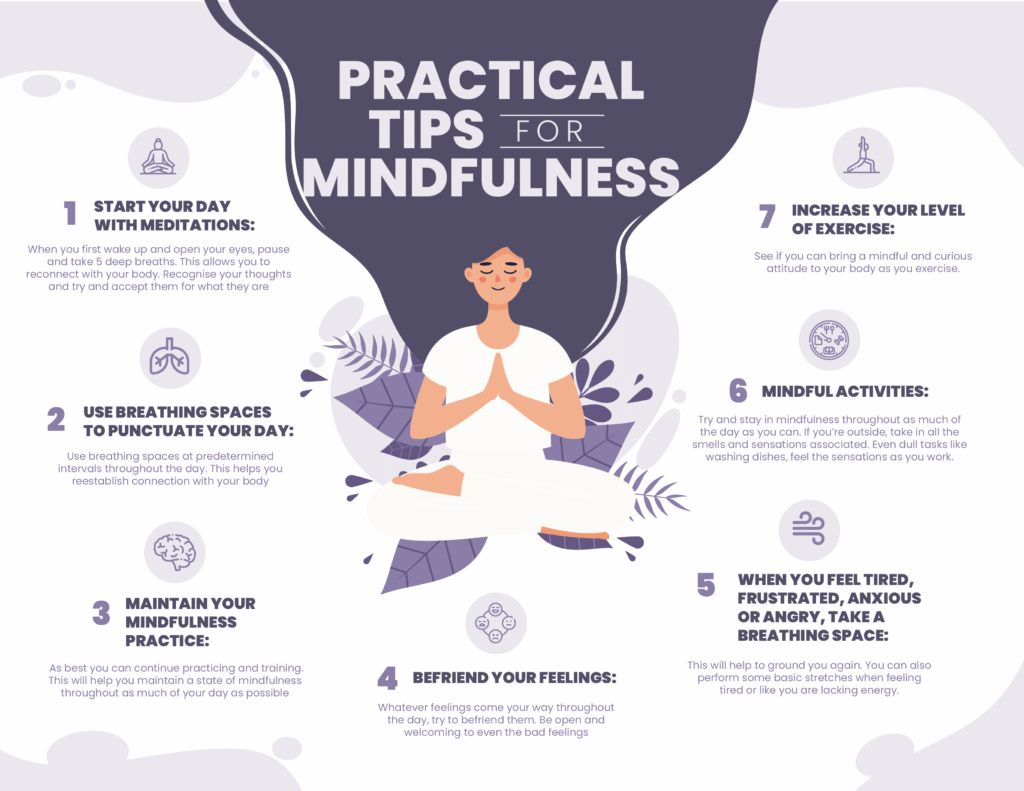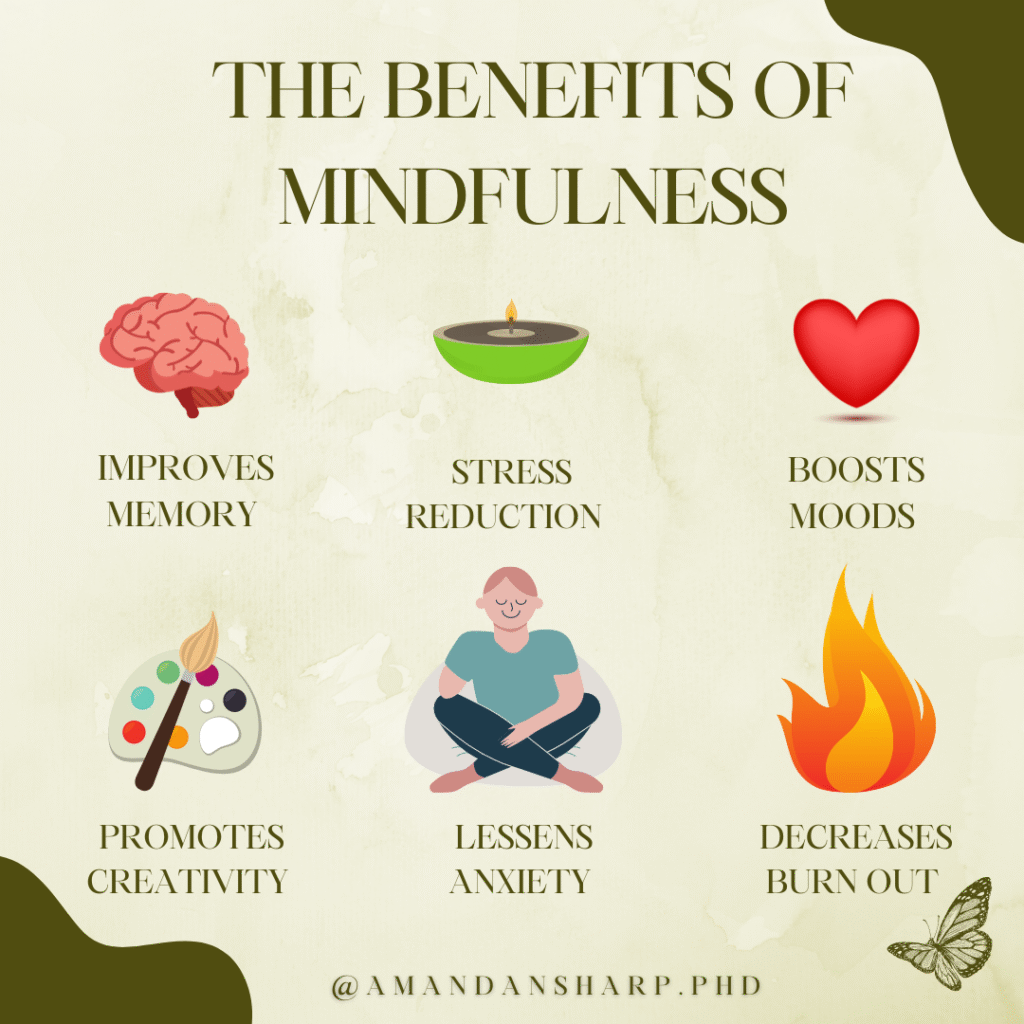In a world moving faster than ever, mental clarity is your most valuable edge. The ability to think clearly—not just quickly—is what separates good from great. Studies in cognitive psychology show that a calm mind processes information more effectively. When paired with mindfulness practices, this clarity becomes a mental superpower. It’s not just about speed—it’s about sustainable performance.
From Silicon Valley CEOs to Olympic athletes, high performers are turning to mindfulness to gain their edge. It strengthens your prefrontal cortex, the brain’s control center for focus, decision-making, and emotional regulation. In a distracted world, that control is priceless. With regular practice, mindfulness helps build cognitive resilience. The result? Faster thinking with fewer mistakes.
Mindfulness also reduces the fatigue caused by mental overload. Constant multitasking, endless notifications, and background anxiety drain your focus. But research from Harvard Medical School shows that even brief moments of daily mindfulness can reverse that. It enhances your attentional control, allowing you to respond instead of react. Over time, this practice leads to deep, lasting focus.
This article will guide you through how to use mindfulness as a daily tool to boost clarity, energy, and creativity. Backed by neuroscience and proven in real-world performance, these techniques are simple yet transformative. You’ll discover how calm leads to speed, how stillness sparks ideas, and how presence powers excellence. Whether you’re in school, work, or creative life, mindfulness fits seamlessly. You already have the power—it’s time to train it.
Your Mind Is Faster Than You Think—If It’s Clear
We often assume that fast thinking comes from pressure or raw intelligence—but that’s a myth. A clear mind actually processes data more quickly because it isn’t bogged down by noise. According to neuroscientists at Princeton, mental clutter reduces working memory and attention. This slows you down, even if you’re smart or motivated. Clarity, not chaos, is what fuels real speed.
Mindfulness works like a mental broom, sweeping away distractions that clog your cognitive bandwidth. It lowers the brain’s default mode network, which is responsible for internal chatter and overthinking. As that background noise fades, your mind becomes more agile and efficient. This mental quiet doesn’t mean emptiness—it means readiness. It’s how elite thinkers enter a state of flow.
A clear mind is also more accurate under pressure. In high-stakes moments, people often confuse speed with haste—leading to poor decisions. But mindfulness improves cognitive flexibility, which lets you shift perspectives and adapt quickly. You don’t just react—you evaluate, pivot, and respond. That’s why mindfulness is used in military training, where fast and calm thinking can be a life-or-death skill.
Students, professionals, and athletes all benefit from this mental upgrade. When your thoughts are aligned and not racing in ten directions, ideas connect faster and answers emerge more intuitively. Research from UCLA’s Mindful Awareness Research Center shows that mindfulness improves memory retrieval and logical sequencing. That means fewer errors, faster problem-solving, and deeper comprehension.
Breath Is Like a Brain Reset Button
When your brain feels overloaded or stuck, your breath becomes your most immediate tool. Controlled breathing has been shown to calm the amygdala, the brain’s fear and stress center. A few intentional breaths help shift from fight-or-flight into focused clarity. This shift supports rational thinking and calm presence under pressure. It’s like hitting “refresh” on your mental state.
The trick lies in the rhythm: exhaling longer than you inhale activates the parasympathetic nervous system. This calms the body, slows heart rate, and clears the mind. Practices like 4-6 breathing (inhale for 4 seconds, exhale for 6) are backed by clinical research for stress reduction. Athletes and performers often use this before high-pressure moments. It’s a reliable, science-backed technique that anyone can learn.
Mindful breathing also improves working memory, helping you access facts, names, or steps when you need them most. Instead of blanking out during tests or presentations, you remain steady and sharp. Even brief sessions—just two minutes of focused breath—can enhance executive function. That’s your brain’s command center for decisions and problem-solving. Breathing right doesn’t just calm—it empowers.
It’s not about forcing deep breaths—it’s about becoming aware of them. Breath awareness anchors your attention to the present, cutting through mental noise. Over time, this awareness becomes a habit, creating resilience in daily stress. According to Yale researchers, students who practiced daily breathwork reported lower anxiety and higher mental clarity. That’s why breath is more than a tool—it’s a habit of clarity.
Stillness Is Not Laziness—It’s Power
In today’s hustle culture, stillness is often mistaken for inaction or weakness. But research from MIT neuroscientists shows that the brain’s most insightful moments happen during restful states. When the mind isn’t cluttered with activity, it starts making deeper connections. It’s in these pauses that original ideas and patterns emerge. Stillness isn’t lazy—it’s a launchpad for insight.
Many of the world’s greatest thinkers, like Einstein and Da Vinci, embraced quiet moments to let ideas unfold. This is now supported by studies on the brain’s default mode network, which activates during rest and mind-wandering. Far from idle, this network fosters creativity, reflection, and long-term planning. When you stop doing, your brain starts processing deeply. That’s how silence becomes strategic.
Mindfulness helps you tap into this mental stillness intentionally. Instead of reaching for your phone in every free moment, you learn to sit and observe. This space invites clarity and reduces the background stress of constant stimulation. According to a study published in PNAS, people who practiced mindfulness regularly had more efficient brain activity during rest. Stillness, then, is not absence—it’s alignment.
Powerful thinking doesn’t always look busy—it often looks still. Moments of quiet are when your subconscious does its best work. In that stillness, you gain perspective that’s not accessible during constant motion. Practicing mindfulness is how you create that space on purpose. And as psychologist Tara Brach teaches, pausing is an act of strength, not weakness.

This infographic titled “Practical Tips for Mindfulness” offers seven simple yet powerful strategies to integrate mindfulness into daily life. From morning meditations to mindful breathing and movement, it emphasizes consistent awareness, emotional balance, and present-moment engagement.
Creativity Grows in the Gaps
Creative insights rarely emerge when your brain is overloaded. They tend to surface in quiet moments—when you’re walking, resting, or simply breathing. Neuroscience confirms that idea generation thrives in downtime, especially when the brain switches from focused thinking to relaxed awareness. This “gap time” is crucial for synthesis and originality. Mindfulness creates that space on purpose.
Mindful silence engages the default mode network—the part of your brain responsible for reflection and imagination. That’s why daydreaming, when intentional, is not a distraction but a creative engine. When you allow your brain to pause, it connects distant dots and forms new solutions. This is exactly why mindfulness improves divergent thinking, a core aspect of creativity. Your best ideas often live in the quiet.
Studies show that teens and young adults who practice mindfulness report better communication and expression. It boosts their ability to write clearly, speak confidently, and think with originality. When distractions fall away, attention becomes sharp—and expression becomes authentic. Instead of copying ideas, they begin to generate their own. That’s the creative power of mindful awareness.
Creative blocks aren’t always a lack of inspiration—they’re often a lack of space. When your mind is packed with noise, your imagination can’t breathe. But a few minutes of mindful breathing can re-open the mental window. This small pause can lead to a breakthrough idea. Mindfulness isn’t about doing less—it’s about thinking better. And in that gap, creativity grows.
Use “Brain Gym” Every Morning
Starting your day with intention sets the tone for everything that follows. Just 3 minutes of mindful breathing in the morning creates a stable mental base. Neuroscientists have found that early mindfulness practice boosts prefrontal activity, improving focus, memory, and emotional control throughout the day. It’s like giving your brain a quick warm-up. This simple habit becomes your internal compass.
Adding a one-word intention strengthens this effect by anchoring your awareness. Words like “focus,” “patience,” or “clarity” prime the mind for goal-directed behavior. When paired with breath, this micro-ritual helps override the stress of external chaos. You start acting from clarity, not reactivity. That’s why mindfulness is often compared to a mental gym.
This daily “brain gym” routine trains your nervous system for calm control. Over time, your body and mind begin to associate mornings with stillness instead of rush. According to a study published in Frontiers in Psychology, morning mindfulness improves sustained attention and reduces cortisol spikes. That means less anxiety and better decision-making. You become the thermostat, not the thermometer.
Even busy people can spare 3–5 minutes for this upgrade. It doesn’t require a special app, cushion, or background music—just breath and awareness. Within weeks, this habit builds mental muscle that shows up during exams, meetings, and tough moments. This is how leaders and top performers create their mental edge. The investment is small, but the payoff is massive.
Mindful Focus Outperforms Multitasking Every Time
Multitasking might seem efficient, but it actually fragments your attention and slows down performance. Studies from the American Psychological Association show that task-switching can reduce productivity by up to 40%. Every switch comes with a “cognitive cost”, draining mental energy and increasing errors. In contrast, mindful single-tasking supports sustained mental clarity. Focusing on one thing at a time creates deeper learning and faster results.
Mindfulness enhances your ability to sustain attention—a crucial mental skill for success. Neuroscience research confirms that focused attention meditation builds concentration and decreases impulsivity. With regular practice, distractions become less sticky and easier to let go. This leads to better task completion and higher-quality output. The mind becomes trained to stay engaged rather than scattered.
Students who practice mindfulness outperform peers in focus-heavy activities like reading, writing, and test-taking. A study published by Edutopia showed mindfulness helps students reduce anxiety while improving cognitive performance. Another report from the Journal of Adolescence found improved academic outcomes and classroom behavior. Instead of splitting attention, mindful students use their full mental bandwidth.
Mindful focus doesn’t just enhance work—it supports emotional well-being too. When you’re fully present, you reduce overwhelm and make decisions with a clear mind. This kind of focus is increasingly seen as a buffer against burnout and fatigue. Research from UC Berkeley’s Greater Good Science Center recommends mindfulness as a daily tool to build mental stamina. In distracted world, attention is power and mindfulness trains you to hold it.
React Less. Think More.
Most of us are wired to react instantly—especially under stress. But mindfulness creates a buffer between trigger and response, giving you time to choose instead of lash out. According to Harvard Health, mindfulness improves emotional regulation by calming the brain’s reactive circuits. It strengthens your prefrontal cortex, which governs logic and restraint. With practice, your reactions turn into thoughtful responses.
This pause between stimulus and action is where growth lives. Mindfulness trains you to notice your feelings without being ruled by them. Research from the American Psychological Association shows that mindful people experience fewer emotional outbursts and regrets. It increases self-awareness, which is essential for navigating relationships and challenges. In short, mindfulness helps you pause, think, and lead with clarity.
In schools and workplaces, this emotional buffer is a game-changer. Mindful students are less likely to react aggressively or shut down under pressure. Programs like MindUP and others have shown measurable reductions in impulsive behavior. Adults who meditate also report lower reactivity during meetings or conflict. Whether you’re navigating exams or tough conversations, this skill preserves energy and protects relationships.
Mindfulness doesn’t erase emotion—it teaches you how to ride the wave rather than drown in it. You learn to respond with intention rather than instinct. A study in Mindfulness Journal confirmed that regular practice improves patience and decision-making under stress. The space it creates isn’t empty—it’s filled with power. And in that space, better choices are made.
Want Faster Thinking? Slow Down First
It may seem counterintuitive, but the fastest minds are often the calmest. When your brain is in a high-stress state, cortisol floods your system, impairing memory and decision-making. Mindfulness lowers stress hormones and allows your mind to operate with greater clarity. According to Harvard neuroscientists, slowing down enhances the brain’s ability to retrieve and organize information. That’s why slowing down is the first step to speeding up mentally.
In stressful moments, people often rush—and make mistakes. But a calm brain is faster because it doesn’t waste energy on confusion or emotional reactivity. Studies show that mindfulness improves cognitive processing speed by reducing mental distractions. It helps you maintain mental clarity under pressure, especially during tests or high-stakes meetings. The mind, when slowed, becomes far more precise.
Mindfulness breathing acts like a reset button for your neural pathways. Just a few rounds of focused breath can quiet racing thoughts and realign your focus. According to the Yale Center for Emotional Intelligence, breath awareness improves judgment and mental readiness. Instead of panicking or freezing, you respond with accuracy and calm. That’s what gives mindfulness its power under pressure.
Slow doesn’t mean less productive—it means more efficient. You reduce errors, process faster, and think more creatively when your system is relaxed. Athletes, doctors, and negotiators use this same principle to stay sharp when it counts. This balance of calm and speed is known as relaxed alertness, and mindfulness helps you enter it at will. It’s not about doing less—it’s about thinking right.

This infographic titled “The Benefits of Mindfulness” visually highlights six key mental and emotional advantages of mindfulness, including memory improvement, stress relief, and enhanced creativity.
Top Performers Use Mindfulness—Not Just Apps
Mindfulness isn’t just for wellness influencers or monks—it’s a core tool used by high achievers across disciplines. Athletes like LeBron James, creatives like Rick Rubin, and entrepreneurs like Marc Benioff credit daily mindfulness for their sustained success. What they have in common is ritual—not reliance on an app. Real transformation comes from regular, intentional practice. Mindfulness becomes part of how they think, work, and recover.
While mindfulness apps can be helpful, top performers go beyond occasional use. They develop systems—like morning meditations or silent walks—that integrate stillness into their daily rhythm. These practices improve neural efficiency, allowing the brain to perform more with less energy. Consistency is the secret ingredient. For them, mindfulness isn’t a hobby—it’s an operating system.
Peak performers understand that mental recovery is just as important as physical effort. Instead of burning out from constant output, they return to baseline faster by using tools like breathwork and meditation. This gives them a psychological edge during high-pressure situations. In fact, many elite sports teams now use mindfulness training as part of their coaching strategy. Focused stillness becomes a performance asset.
What separates top thinkers isn’t just intelligence—it’s clarity, presence, and composure. These are qualities that mindfulness reliably cultivates. Research from Harvard Business Review shows that leaders who meditate are more emotionally intelligent and decisive. They don’t use mindfulness occasionally—they rely on it. It’s not an extra layer—it’s part of their core.
Your Mind Is the Place Success Begins
Every achievement, from launching a startup to acing an exam, starts in the mind. Your thoughts shape your energy, choices, and outcomes. That’s why mental clarity is the most underrated success tool available to you. With mindfulness, you can train your brain to stay focused under pressure and resilient in uncertainty. The results don’t come from outside—they begin internally.
Mindfulness builds core capacities like creativity, emotional balance, and concentration. These are the same traits linked to long-term success in leadership, education, and innovation. Instead of chasing motivation, you begin cultivating mental discipline. The practice is simple, but the shift is profound. You stop being ruled by your environment—and start guiding your own mind.
You already have focus, calm, and insight within you—mindfulness simply uncovers them. When you sit with your breath, or observe your thoughts, you’re not adding something new—you’re revealing what’s always been there. Studies in contemplative neuroscience show that regular practice strengthens self-awareness and reduces emotional reactivity. You become your own source of stability and insight. That’s where true power begins.
Success isn’t just about action—it’s about awareness. And mindfulness is your daily tool for refining that awareness into strength. Whether it’s five minutes or fifty, consistent practice rewires your brain for clarity and presence. As Jon Kabat-Zinn puts it, mindfulness means paying attention, on purpose, in the present moment—and without judgment. That’s where your next breakthrough begins: right now, in your own mind.
20 FAQs on Think Bigger, Faster, Clearer: How to Use Mindfulness to Unlock Mental Superpowers
What is the connection between mental clarity and thinking speed?
Mental clarity reduces internal distractions, which allows the brain to process information more efficiently. A calm, focused mind isn’t slowed down by stress or overthinking, making it easier to retrieve information, solve problems, and make quick decisions.
How does mindfulness help reduce mental distractions in everyday life?
Mindfulness trains your attention to return to the present moment, cutting through the noise of mental chatter. It reduces activity in the brain’s default mode network, which is responsible for overthinking, and helps you stay grounded in what matters right now.
Why is stillness often misunderstood as laziness, and how is it actually productive?
Stillness is often seen as doing nothing, but it actually gives the brain space to form connections, reflect, and generate ideas. Neuroscience shows that some of our most insightful thoughts arise during quiet periods when the mind is at rest—not while it’s busy.
Can mindfulness improve creativity, and if so, how?
Yes, mindfulness creates mental “gaps” where new ideas can form. It quiets the analytical mind and activates the brain’s default mode network, which helps with divergent thinking, imagination, and the synthesis of disconnected concepts into something original.
How can I create a short, effective morning routine to sharpen my focus?
A simple routine of 3 minutes of mindful breathing followed by setting a one-word intention—like “clarity” or “focus”—can prime your brain. This daily practice improves prefrontal activity and creates internal alignment that shapes how you respond to the day ahead.
Why does single-tasking lead to deeper learning than multitasking?
Multitasking forces your brain to constantly switch attention, which drains energy and reduces comprehension. Mindful single-tasking, on the other hand, deepens focus, minimizes mistakes, and strengthens memory retention and learning speed.
What role does mindful breathing play in calming the brain?
Mindful breathing regulates your nervous system by activating the parasympathetic response. This reduces stress hormones, calms the amygdala (your fear center), and restores cognitive balance—making it easier to focus, solve problems, and stay emotionally steady.
How does slowing down help you think faster and recall information more clearly?
Slowing down allows your brain to access deeper memory pathways without interference from stress. When you’re calm, your cognitive speed increases because you’re not wasting energy on panic, overreaction, or mental clutter.
What are the long-term mental benefits of daily mindfulness practice?
Regular mindfulness strengthens areas of the brain linked to focus, emotional regulation, memory, and creativity. It also rewires your response to stress, reduces impulsive reactions, and enhances your ability to stay present under pressure.
How can mindfulness improve emotional control and reduce overreaction?
By increasing the space between stimulus and response, mindfulness allows you to observe your emotions before reacting. This improves emotional intelligence, reduces regretful decisions, and helps you respond with intention rather than reflex.
Why do high-performing individuals and leaders prioritize mindfulness?
Top performers use mindfulness to maintain mental clarity, manage stress, and access creative insights. For them, it’s not a luxury—it’s a daily tool to stay sharp, focused, and resilient in high-pressure environments.
How does mindfulness training increase attention span and reduce burnout?
Mindfulness enhances sustained attention and reduces mental fatigue by minimizing constant cognitive switching. It helps your brain rest and recover during brief pauses, protecting it from the chronic overload that leads to burnout.
What are simple ways students can integrate mindfulness into their study routines?
Students can start by practicing 2–5 minutes of breath awareness before studying, setting a study intention, and taking mindful breaks to reset their focus. This helps them avoid distractions and improves comprehension and recall.
How does breathwork affect the nervous system and emotional regulation?
Breathwork balances your autonomic nervous system by shifting it from a fight-or-flight response to a rest-and-digest mode. This reduces anxiety, slows heart rate, and improves your ability to remain composed during emotional or high-stakes moments.
Can mindfulness help with decision-making under pressure?
Yes, mindfulness sharpens the brain’s executive function, which governs logic, judgment, and self-control. It gives you the clarity to weigh options, reduce impulsiveness, and choose actions based on thought—not stress.
How does taking mental pauses contribute to idea generation?
Mental pauses, especially those involving silence and breath, allow your subconscious mind to connect ideas. In these quiet spaces, the brain relaxes and begins processing information creatively, often leading to breakthrough insights.
Why do many people experience their best ideas during quiet or idle moments?
During rest or idle time, the brain’s default mode network becomes active, which supports reflection and creative thinking. These moments allow ideas to incubate, free from distractions and cognitive demands.
Is mindfulness more effective when used with apps or as a daily ritual?
While apps can be a helpful starting point, mindfulness becomes truly effective when practiced consistently as a daily ritual. Regular routines build mental discipline and internal focus that go far beyond app-guided sessions.
What kind of brain changes occur through regular mindfulness practice?
Research shows that mindfulness increases grey matter in regions related to focus, memory, and emotional regulation. It also decreases activity in the brain’s fear and stress circuits, creating long-term improvements in mental and emotional performance.
How can mindfulness reshape the way you experience success and achievement?
Mindfulness helps you define success based on clarity, intention, and alignment rather than just speed or output. It allows you to pursue goals with calm energy, adapt to challenges thoughtfully, and experience fulfillment rooted in presence.
–Authored by Barsha





